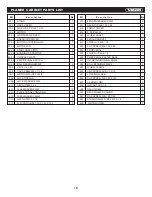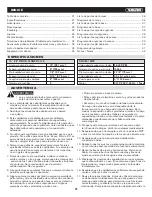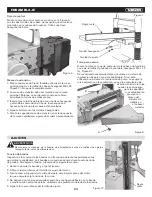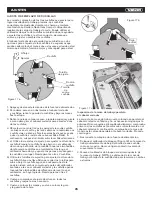
12
TROUblEShOOTING: MEChANICAl AND ElECTRICAl PROblEMS
Machine will not
start/restart or
repeatedly trips
circuit breaker
or blows fuses.
Overload automatic re-set
has not reset.
Planer frequently trips.
Building circuit breaker
trips or fuse blows.
Loosen electrical connections.
Motor starter failure.
Motor failure.
Miswiring of the machine.
On/off switch failure.
When the planer overloads on the circuit breaker built into
the motor starter, it takes time for the machine to cool down
before restart. Allow unit to adequately cool before
attempting restart. If problem persists, check amp setting
on the motor starter inside the electrical box.
One cause of overloading trips which are not electrical in
nature is too heavy a cut. The solution is to take a lighter
cut. If too deep a cut is not the problem, then check the amp
setting on the overload relay. Match the full load amps on
the motor as noted on the motor plate. If amp setting is
correct then there is probably a loose electrical lead. Check
amp setting on motor starter.
Verify that planer is on a circuit of correct size. If circuit size
is correct, there is probably a loose electrical lead. Check
amp setting on motor starter.
Go through all the electrical connections on the planer
including motor connections, verifying the tightness of each.
Look for any signs of electrical arcing which is a sure
indicator of loose connections or circuit overload.
If electric motor is suspect, you have two options: Have a
qualified electrician test the motor for function, or remove
the motor and take it to a qualified electric motor repair
shop and have it tested.
If the on/off switch is suspect, you have two options: Have
a qualified electrician test the switch for function,
or purchase a new on/off switch and establish if that was
the problem on changeout.
Double check to confirm all electrical connections
are correct and tight.
Examine motor starter for burned or failed components.
If damage is found, replace motor starter. If motor starter
looks okay but is still suspect, you have two options: Have
a qualified electrician test the motor starter for function, or
purchase a new starter and establish if that was the
problem on changeout.
If you have access to a voltmeter, you can separate a
starter failure from a motor failure by first, verifying
incoming voltage and second, checking the voltage between
starter and motor. If incoming voltage is incorrect, you have
a power supply problem.
If voltage between starter and motor is incorrect, you have
a starter problem. If voltage between starter and motor is
correct, you have a motor problem.
Probable Cause
Remedy
Verify unit is connected to power
No incoming power.
Trouble
Summary of Contents for KN CM-15W3
Page 43: ...42 NOTES NOTAS ...
Page 44: ...www knova com mx ...














































